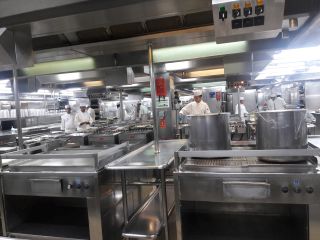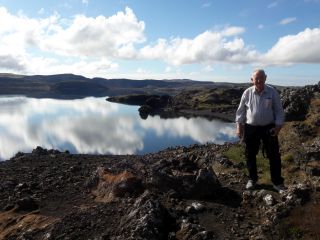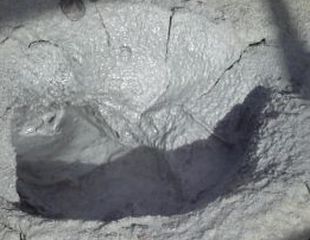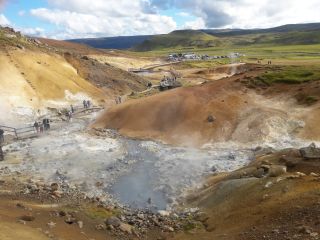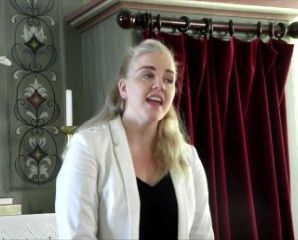We flew from Israel to
London where we overnighted. Walking to our favorite restaurant in
Chinatown we
stopped by a new Chinese restaurant that was packed and decided we
should eat
out of our comfort zone. Big mistake. We’ll rectify it on our way back!
Next morning we took a cab to
Southampton to board P&O
Oriana. It is a mid-size ship with 1,880 passengers and 760
crew. Our luggage was immediately whipped away to later
re-appear in our
cabin. We arrived earlier than advised, but received
a disc and told to wait until our
disc
was called. A few minutes later we began the smooth and speedy
procedures of
registering, boarding and receiving all information.
Food is served in The
Conservatory throughout the day and until well past midnight.
Norovirus: we had
never heard of this virus but it seems it is the scourge of sailing
causing
vomiting and diarrhea. To prevent this
we had to wash our hands with Purell an anti-viral and anti-bacterial
gel before entering all areas that serve food. If
going for a second helping, clean plates and cutlery had to be taken
each time.
No
it didn't prevent us from stuffing ourselves at each sitting!
The cabin was comfortable, much more spacious
than expected with a window onto an aft deck. I loved the pampering of a clean room with
fresh towels twice a day. The crew was most friendly and helpful; the
majority
of the food staff is from Indian, Catholics from Goa who speak
excellent
English. The last
sentence causes me to smile. Many
years ago while Eitan was directing a bridge tournament in Jesolo in
Italy I
saw an advert for Shakespeare’s Much Ado about Nothing. With great
expectation
I bought a ticket and arrived at the open air theatre. When the play
started I
found out that the company was from India and their original language
was Urdu. The subtitles in Italian didn't help much!
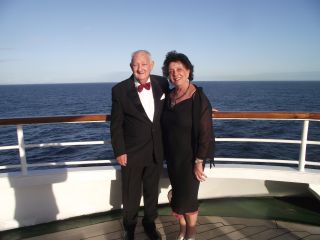
Each day we were instructed on how to dress for dinner – casual on
shore days and black tie when at sea.
There are four large dining areas
and we chose to have dinner at a second seating at 8.30pm. When we
sat
downfor our first dinner the other four people at the table didn’t
greet us. Finding the
diners
most unfriendly we asked to change tables. The second table diners were
much
more friendly people but they disappeared after two nights to earlier
and
flexible dining. We could have changed tables not to be alone but we
liked our
waiter Maures too much and found it quite a relief not to have to make
conversation the whole time. We see that it would be nice to make the
voyage
with friends.
There are many bars, a
library and a casino. There are also a
variety of live shows, dancing, lectures, gym, Pilates, yoga, a beauty
shop,
cinema and shops. Theoretically one can board a ship and not spend
another
penny as all food and entertainment is provided. When the boat docks,
shuttles are provided into town and one can go ashore
and
wander around the towns where we stop.
The ship, however, does its best to squeeze as much money as
possible from
passengers, in the nicest way. Besides
our designated dining area there are two other restaurants which have a
cover
charge and they are well worthwhile. There are specials if you buy a
wine
package, bottled water or a coffee package. The duty free shops are
always
advertising some special when at sea. The gym is free but Pilates and
yoga
cost, and of course there is a special on that too. My best special was
the daily
cocktail. Sitting in the Tiffany lounge under a huge art deco ceiling
reminiscent of the Titanic was so civilized and adult.
On our first day at
sea I joined a Pilates class. At 2.00pm we played bridge. That evening
it was a
black tie event with drinks preceding the meal while after dinner we
choose to
see a movie Hidden Figures. We came to relax but were busy all the
time.
Our
first stop was
at
Belfast. We took a taxi to the Titanic
Exhibition. Well worth the visit. It began with a fascinating overview
of the
wealth of Belfast in the early 20th century, based on hemp,
Harris
Tweed, ropes, whisky, machinery and ship building. It was in Belfast
where the
Titanic, the largest ship built up to then was built. It was designed
as a ship that could not sink, but human
error and misjudgment overcame
that, causing the
ship to crash into a huge iceberg at full speed. The tragedy,
hugely shaped by the last Titanic movie with Leonardo DiCaprio and Kate
Winslet
grips our imagination even today.

Another sea day followed by a stop at Stornoway in the Outer Hebrides, part of Scotland.. We took an adventurous tender ride to shore.
On the Tour of the Best of Stornoway we stopped at the Arnol Blackhouse. A long house divided up into living room, cooking area and animal quarter whose natural heat helped to warm the houses in winter. Peat is used for heating houses, cooking and even as insulation in building. It is the remains of partially decomposed moss that grows in bogs.
In the blackhouse it was very smoky although the area above the fire was not covered with straw thatch to allow smoke to escape. The thatch is later used as fertilizer when it needs to be replaced. Double dry walls are filled with dried peat.
Later houses were much more modern with a proper fireplace and chimney. Either way it looked a very bleak existence with an extremely harsh climate, although residents remember the family gatherings and friendship around the smoky fires.
We bought fruit cake laced with whisky for Caroline and whisky sauce for my pancakes. At a little store by the blackhouse we were delighted to see that Peter May, a prolific author, has written a series of mystery novels centred around the Blackhouse and Lewis Island. We later downloaded the books on Kindle.
Then off to Callanish, standing stones laid out in a cross with an ancient burial site in the middle. The stones, aligned with the moon and stars, are thought to have helped Neolithic farmers gauge the seasons. They date back 5000 years. We went mainly as a tribute to our two grandsons, Maayan and Itamar who insisted we visit Stonehenge when we took them to London last year.
ICELAND (REYKJAVIK, ISAFJORDUR, AKUREYRI)
REYKJAVIK - ICELAND
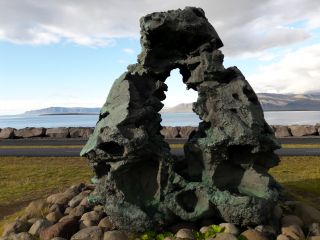
Another sea day followed by arriving at Reykjavik Iceland. A new country to add to the list. Population of the whole country is 330,000; they have about 4 sheep to every person.
A branch of the Gulf Stream makes the climate more temperate than places at the same latitude in America.
Despite a very mediocre guide we enjoyed a pleasant morning. Iceland is formed out of volcanoes along the mid-Atlantic ridge and there are more than 5 different kinds of volcanic stone. Reykjavik has modern buildings with grass and flowers but leaving town everywhere the ground is black from the volcanic stone, tempered by greenish grey moss that covers all surfaces. In some places, especially where there is a slope there are grasses and scattered flowers but no trees
The houses
look very
flimsy and we were told they had to be of concrete with light roofs
because of
the many earthquakes they suffer. Geothermal
vents heat their houses and water system. Cold water is free.
We stopped by a
large lake, quite beautiful with its reflection of hills in the still
waters where trout have been introduced. Then
on to
geothermal park Seltun with bubbling mud and sulphurous smells.
Then a long drive to the Viking museum. The
Viking landed in Iceland and later proceeded to northern America some
500 years
before Columbus discovered it for Europe.
After
lunch and a rest we took a shuttle into town. Harpa, the huge theatre
and music
venue is a striking and unusual building. It is made up of glass
hexagonals –
excellent lighting for winter when they get only about 4 hours of light
a day while
the vacuum inside the glass hexagons provides excellent insulation.
We
walked into town and had coffee but it
started to rain so we returned by shuttle to the ship. I
returned to town to see a stunning sculpture
Sun Voyager and walked back to
the ship passing the house where Gorbachev and Reagan met in 1986
signifying
the end of the Cold War. Hmmm with rhetoric between America and N
Korea
heating up it may need to be used again. A nice hour-long walk brought
me back
to the ship.

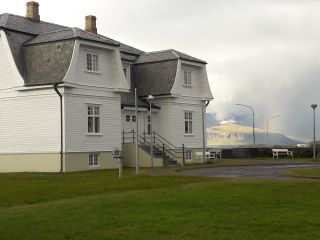

Sailing through the night we arrived at
Isafjordur and
needed a tender to go ashore.
Our first stop on the tour was at
Skutulsfjordur
where we were treated to a glass of sparkling water straight from the
stream. Blueberries are
just
coming into season and I picked them growing on low bushes by the
stream. They
were still small, but tasty.
We were concerned how people reacted to a period with no sun.
Iceland in winter gets about 4 hours of light a day but the sun never
rises above the horizon. Our guide said she takes massive doses of
vitamin C and D and has special lamps so that she wakes up to sunlight
and goes to sleep with the 'sun' setting. When the sun does rise above
the horizon they have a huge pancake festival
Our next stop was at
the Maritime Museum in one of Iceland’s oldest houses.
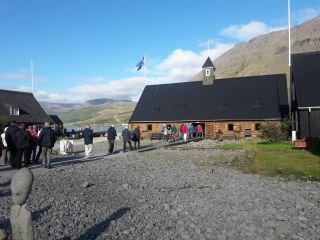
Our excellent
guide
invited us to taste some of Iceland’s specialty foods – biltong-like
dried cod
(tasty) and small cubes of fermented shark (an acquired taste if you
are an Icelander). The latter was a surprise but it
seems that
these icy waters are home to the blind, deep water Greenland shark. The
sharks used
to be
caught and gutted, keeping only the liver for oil, but today they
ferment the
meat and eat it as a traditional food. It still tasted of ammonia. Of interest in the museum were the Cod Wars
1952-1976. The rich fishing grounds around Iceland’s seas were
being
depleted by countries, particularly Britain, coming to harvest the
fish,
especially cod. The wars started when Iceland placed a 4-mile fishing
limit
on
foreign ships. Reaction was swift and Britain banned the import of
Icelandic
fish. Gradually Iceland extended its fishing jurisdiction to 12, 50 and
finally
200 nautical miles. British navy and tugboats and even aircraft were
brought to
enforce British fishing in these rich waters until Iceland devised a
wire
cutter, severing the trawlers' catches. Eventually an agreement was
reached in 1976 whereby British
trawlers
could fish within the 200-mile limit. Six months later the British
trawlers
peacefully pulled out of Iceland’s fishing grounds.
Today most countries have a 200-mile fishing
limit for foreign ships.
At Osvor
by the sea
we visited
a recreated fishing station from the 1800's. Many houses in Iceland
have grass
growing on their roofs to help insulate the houses. A fisherman was
dressed in
traditional oilskins – sheep’s skins soaked in fish oil, so slippery
that they
had to have a rope tied around their waists in case they slipped
overboard. They had unusual gloves, no
division for fingers but with two thumbs knitted on either side of the
hand so
that when the one side was worn out because of rowing and hauling in
the
fishing lines they could just turn the glove around and use the other
side.
In the beginning the fish were
cleaned and filleted and placed in airy wooden structures where they
would dry (stock fish).
Later they found that if they salted the fish it would dry quicker.
Osvor had a
hut for tools, another for sleeping and salting the fish and another
for
drying.
Cod here is eaten fresh but salted and exported as bacahlau to
Spain,
Portugal, South America and the Caribbean. The dried heads are exported
to
Nigeria, but no-one could tell us what they do with them there.
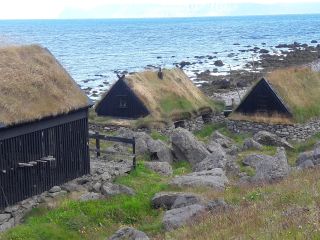
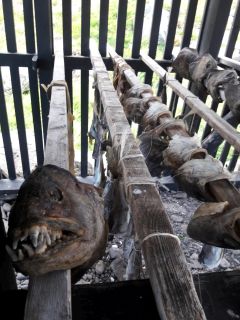
That night the ship
had to change course to come around and enter a new fjord, so for 1 ½
hours we
were sailing within the Arctic Circle. The sway of the boat was
different and
all the passengers leaving the night’s entertainment looked as if they
were
drunk as they tottered along the corridors. It was hard to go to sleep
and we
thought how lucky we were that up until then the sea was very calm. You
know it
is rough when paper packets are strategically placed throughout the
ship for seasick passangers.
Out final stop in
Iceland was at Akureyri.
Jafet Olafsson, a fellow member of the European Bridge Executive
met us
at the port and showed us around for the day. Although he and Hildur
live in Reykjavik
they have a summer home in Husavik about 80 kilometres from Akureyri.
We
figured that he had travelled some 400 kilometres that day showing us
around!
Our first stop was at the magnificent Godafoss Falls. The name means Fall of the Gods and refers to the adoption of Christianity by the Icelanders 1000 years ago. The Lawspeaker on conversion to Christianity threw his pagan Norse gods into the waters. But despite Christianity being the official religion people still had freedom of religion at home. How liberal and modern they were. Althing is the name of Iceland's parliament, established in 930 CE as an outdoor assembly for all free men. It is the oldest parliament in the world.
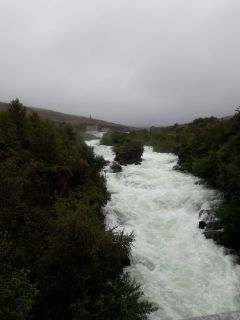 The river and falls
are not fed by springs but rather by melting snow.
The river and falls
are not fed by springs but rather by melting snow.
Our next stop was at
Namafjall Hverir, a geothermal area similar to what we saw at Stornoway
but
with numerous fumaroles billowing smoke.
The Blue Lagoon is a favorite excursion from
Reykjavik
but we saw a smaller one and were surprised that the water is really
blue and the small waves formed by the windy weather were blue.
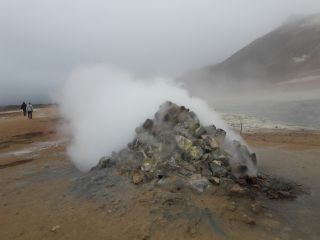
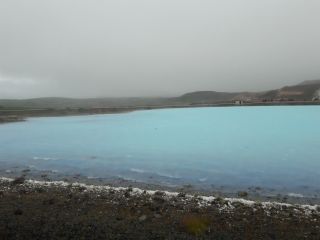
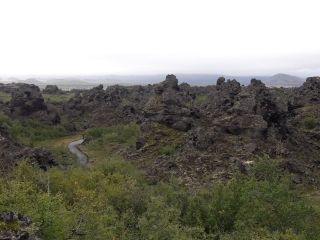
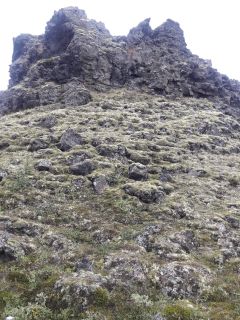
Near Jafet’s summer
home in Husavik we visited an old farmhouse which obviously belonged to
wealthy
farmers and was very big, if cold
While
talking it occurred to me that Jafet
actually had
Viking blood flowing through his veins.
Neat.
After
lunch he showed
us the fishing lodge that the family owns and took us to the river
where
fisherman
catch and release salmon from the banks of the river as it is too deep
and
swift to stand in it. Jafet then drove us
80 kilometres back to the dock.
Always on the
lookout
for unusual products, back at the port I bought shark face cream, with
shark
liver oil. Well sharks have been around for millions of years and I’ve
never
seen a wrinkled shark so I thought I would try it. There
was also a delightful family
of fluffy polar bears. The last live polar bear to be seen in the
area was in 1960 and unfortunately it was
shot.
Icebergs don’t reach Iceland any more; the glaciers are receding and
snow is now
intermittent in winter.
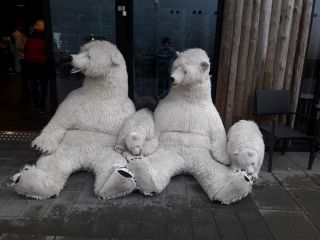
KLAKSVIK and VESTMANNA - FAROE ISLANDS
We had been most impressed by the efficiency and accommodating nature of the ship’s personnel, but that changed with bridge. In the daily bulletin there was a daily notice that there would be non-hosted bridge in the card room at 2.00pm. We went and played. After the second time, to everyone’s delight, Eitan offered to organize a bridge tournament on the next sea day. Repeated requests to publish it in the daily bulletin met with no response but Eitan organized it anyway. A young woman from the entertainment committee was sent to tell us that we couldn’t have the competition as only hosted events could hold competitions. Eitan’s suggestion that they call it a duplicate game with no mention of a competition was also rejected and nearly caused a mutiny. The 6-7 table duplicate competitions were very successful and and appreciated by the players.
After
a day at sea we arrived
at Klaksvik, one of the Faroe Islands.The Islands have their own
land, flag, currency, and parliament but belong to Denmark, which
determines
its foreign policy. However, in sports, Faroe has its own national
teams.

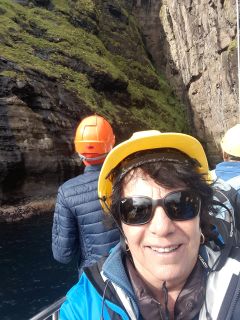
While
Eitan chose to go
independently ashore and take pictures, I took a shore excursion to
Vestmanna
Cliffs. There are 18 Faroe Islands and only one is
uninhabited. The
population is just over 50,000 people with many more sheep. The
wealth of
the islands is pelagic fishing for herring and mackerel and very
prosperous
salmon farming. Because of the sea temperature and currents and I
suspect lack
of overcrowding there is not a problem with parasites like sea lice as
in
Norway. To get to the nearby island of Streymoy where we were to catch
our boat
ride we drove through a 5-kilometre tunnel that goes under the
sea! The
islands here were also formed out of volcanic or basalt rock but they
are much
older than those formed in Iceland. The result is that there is much
more
weathering; the rock has broken down into a rich soil and there are
grasses,
bushes and some flowers, but no trees.
After
a 1 ½ hour drive we boarded
the boat, which thankfully had a very nice toilet. It was freezing cold
but
afraid of being sea sick; I chose to sit up on deck. We reached the
cliffs which rise almost vertically from the sea.
Wherever
there is a slope covered with grass there are sheep grazing. It is
surprising
to learn that the sheep don’t slip down the steep slope and fall into
the
water. They remain outside all winter (except those that are rounded up
by dogs
for slaughter) and can find shelter in special refuges built for them.
When
we reached the bird cliffs we
had to put on hard hats in case of falling rocks. The 600 meter
high cliffs are very weathered and form beautiful
shapes,
columns and grottoes covered with bird guano.
The
small grass covered ledges are the Atlantic Puffins’ nesting grounds.
We learnt
to identify puffins by the rapid beat of their short wings. This
enables them
to swim underwater as well. They looked much smaller than the cute
stuffed
puffin toys that are sold in souvenir shops.
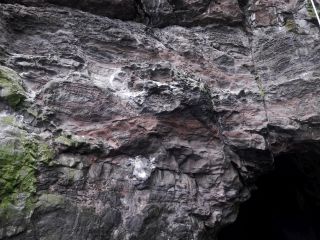
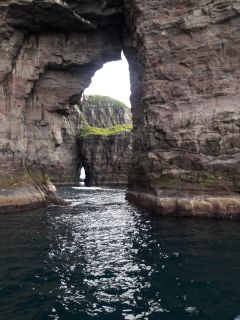
We
also saw razorbills,
seagulls,
fulmars and guillemots that come here to breed and feed on the
plankton-rich
waters and
passed salmon
nets in
the sea and liked the way the salmon were jumping in the water. It
was an exhilarating trip and well worth the long drive there
and
back.
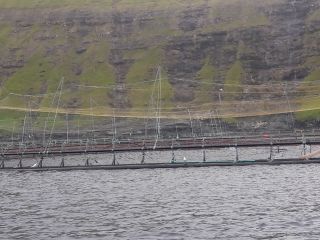
That
evening I enjoyed a private
Pilate’s class as none of the other people turned up. While
enjoying our
delicious dinner we watched as waiter after waiter came out of the
swinging
doors of the kitchen carrying trays laden with dishes. I wanted
to see
their kitchen and was delighted when told
that there was a select tour of the kitchen going to take place and it
was possible to join. I registered
immediately.
The
weather had been cold and even
raining most of the day, but just before we left Klaksvik the sun came
out and
there was
a great band playing by the swimming pool with people all around on the
various
decks. It was coffee (Eitan), cocktail (me) and dance time and was
great fun.
KIRKWALL
- ORKNEY
ISLANDS, SCOTLAND
The
following morning we arrived at
Kirkwall in the Orkney Isles, part of Scotland. It is an archipelago
made up of
70 islands; they are formed from sandstone when the land was under the
sea
millions of years ago. Farming, mainly cattle farming of Angus beef is
their
main source of income. In the morning we caught the shuttle into town
and
walked around. The most striking difference was that the buildings were
much
more massive and made from stone and had a dull colour, unlike the
houses on
the previous islands we visited where they were brightly painted. You
know that you are in
Scotland
when you hear this on arriving in town -
There
were some fine shops displaying woolen clothes and attractive jewelry
and
tearooms. We found a tearoom that served scones (delicious) and
also had
Wi-Fi so we could catch up on family events by downloading pictures
sent to us on WhatsApp. From another bakery I bought a date and ginger
scone
for my tea and it proved to be as delicious as it looked!
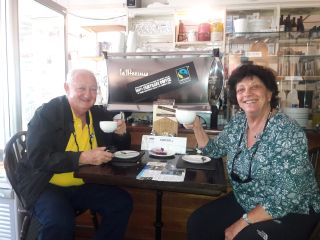
We
returned to the ship for an early
lunch and then disembarked to join our afternoon tour Orkney’s
Archaeological
Wonders. What can I say? The tour fulfilled its promise and we were
enthralled
by the stories of our most eloquent guide, Chris. Our first stop was at
the
Ring of Brodgar, a UNESCO World Heritage Site. It
consisted of a ring of 63 tall standing stones surrounded by a henge
(trench)
dating back to 2800-2500 BCE. Today only 27 stones remain. The stones
are in four
groupings, each group formed by stones from a different area. Since
there are
no trees it remains a mystery as to how Neolithic man transported these
stones
over water and up to the site. The implements used to cut the trench
out of the
rock were from flint (imported) and antler bones. There are no burials
within
the ring, but there are burial mounds nearby. In common with the many
other
stone circles archaeologists are not sure of the significance of the
stones.
The way the suns’ rays hit far mountains may signal the solstices.
Since the
stones come from different sites it suggests a great deal of
cooperation. It is
thought to be a ritual and religious site. We walked around quite
enchanted by
the place.
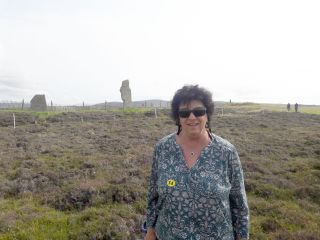
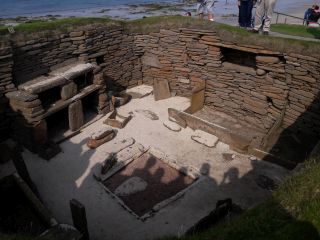
During the second period the houses were built into the mounds of the dried waste that had built up and perhaps gave them shelter from the harsh winds of the Atlantic Ocean. Before the second level was built there was considerable planning and a sewage system to carry waste from the indoor toilets was built! The houses also had a central fire, beds and shelves. Men were about 5 foot 6 inches and women slightly shorter, an impressive height for 4000 years ago.
To add more details that boggle the mind they had a clay covered depression filled with sea water where they could hold live fish or seafood. Their skeletons, however, showed signs of deficiencies of vitamins C & D (fresh fruit and sunlight). At Stonehenge archaeologists have recently uncovered a site with thousands of skeletons of pigs. Tests on their bone composition revealed that the pigs came from Skara Brae, 650 miles away by sea. That meant there had to be regular contact between the sites. Transporting so many animals by sea demanded excellent sailing skills and a high degree of organization.
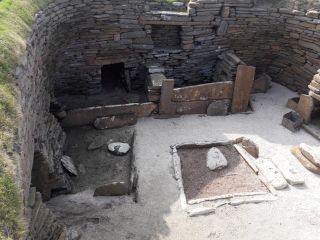
After 600 years of occupation the site was abandoned. Theories are that the site was for priests/priestesses who were fed in large by outlying communities. 2500 years ago the weather became very harsh and perhaps the community could not sustain itself as agricultural hinterland decreased. Another theory is that when the priests at Skara Brae disappointed by not stopping the coastal erosion and loss of farming areas, people from surrounding sites were no longer prepared to support them. Theories abound but no-one really knows. The level of planning, furniture found in one house with two women buried under the floor, give no answers as to who lived in those houses and why it was abandoned after 600 years of good living.
Afterwards
we walked over to
Skaill House, an impressive stone mansion first built over 500 years
ago by the
Bishop of the area. The dining room was set with a beautiful
blue
dinner service that Queen Mary had dined upon when visiting. But more
impressive was
the simpler and more colorful crockery in the display case. It seems
that after
Captain Cook was murdered in Hawaii in 1779 his crew was not paid for
many
months. When they arrived at the Orkney Islands the crew sold off the
crockery
to recuperate loss of wages.
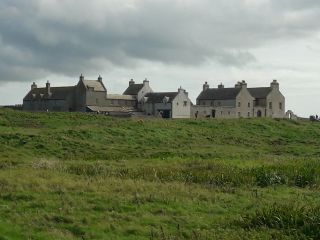
When
we returned to the ship, on the
aft deck there was a British festival with Pimm’s No. 1 being served
(bought),
little British flags and lots of English songs including Rule Britannia
and God
Save the Queen.The overwhelming majority of passengers were from
Britain and the entertainement crew expressed British pride and
patriotism,
and lots
of fun.
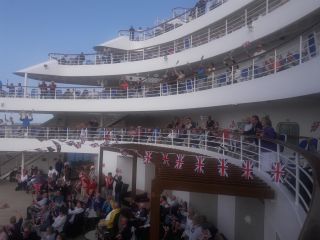
We were delighted that Maureen and Paul Porteous, the Secretary of the European Bridge Executive, who live in Dublin, met us at the ship and spent the day showing us the highlights of Dublin. Dublin is a lively place and the town was packed, owing to three cruise ships in port. Most of the roads in town are one way streets and parking is virtually impossible.
On the way we drove along the River Liffey and were touched by the Famine Statues, a dramatic depiction of emaciated people making their way to the famine boat which would take them to America. In the mid-19th Century Ireland was devastated by potato blight, so severe that 1 million people died and an equal number emigrated, mainly to America.
We
made our way to Trinity College to see the
exhibition of The Book of Kells. We had never heard of it although it
is
advertised as the world’s most famous medieval manuscript. It is a 1200
year
old book of the Gospels written in Latin on vellum (treated calfskin).
The
beautiful writing is interspaced with richly decorated and breathtaking
illustrations.
Earlier books are also on display including a small pocket Gospel.
While the
large books were placed in a cathedral for display, the pocket Gospels
are
unique to this period and are portable.
We
also visited Trinity’s Library the Long Room. It is a
copyright library meaning that all books printed in Ireland are housed
there as
well as some 200,000 ancient books in a single hall. The two-storied
library
is
stunning It also houses an ancient harp, the Brian Boru harp,
believed to
have belonged to the King of Ireland. It dates back to about the 14th
century and is a model for the coat of arms of Ireland.
As
we walked through the beautiful grounds an
enormous, a truly enormous tree caught our attention. A friend of Paul
and
Maureen, who is a tour guide, was passing and explained that it is a
maple tree from Canada.
By
this time we needed to refresh ourselves with
tea and scones at a fashionable café.
We
then made our way to the National Museum of
Ireland to see Bog Men. These are Iron Age bodies that have been
preserved or rather pickled in bogs. Bogs lack oxygen and are acidic
which
means the body parts have not decomposed and they are naturally
mummified. In
addition, the peat stains the skin brown.
The
bog bodies on display have skin that looks
like leather. It is believed that they were ritually sacrificed to
place their
bodies at the tribal boundaries of the kingdoms. The latest
theories
suggest that these bodies were sacrificed at the start of the reign of
a new
king as a symbol of his authority. Bog bodies have been found in peat
bogs
throughout Northern Europe.
Other
interesting displays at the museum were of
Bronze Age gold ornaments and a raft, carved out of an exceptionally
long
log.
We
were delighted to take a picture by the statue of Molly Malone. We both
know the 19th century song (which is Dublin's unofficial anthem) about
the fishmonger Sweet Molly Malone in Dublin Fair City who wheeled her wheel-barrow, Through streets
broad and narrow, Crying, "Cockles and mussels, alive, alive, oh!".
Although she is a
fictional character 13 June is proclaimed as Molly Malone Day. In churches I’ve seen bronze statues of
saints whose hands or feet shine brightly because of the thousands of
people who
touch them. Note where Molly shines!
After a delicious lunch we drove to the Malahide Castle, but it was late and although we could walk around the lovely gardens we couldn’t enter the castle itself. Paul and Maureen drove us back to the ship, happy and tired after an exceptional day with good friends.
On
our last day at sea I signed up for a tour of
the kitchen. We knew that the galley had to be amazingly efficient to
get out
so many meals quickly and prepared to order. If you ordered your meat
medium-rare that’s
how it arrived.
The tour started with champagne and canapes. The huge
kitchen
is situated between the two main dining rooms with elevators going up
to the
other dining rooms and restaurants. The numbers are impressive. Every
day the
kitchen staff prepares 7,000 meals for passengers and crew. All food is
taken
aboard at Southampton and has to be ordered at least two and a half
months in
advance. This includes tons (literally) of meat, fish and game and
fruit and
vegetables. The wine cellar stocks some 60,000 bottles of wine and
beer.
The numbers are mind numbing.
